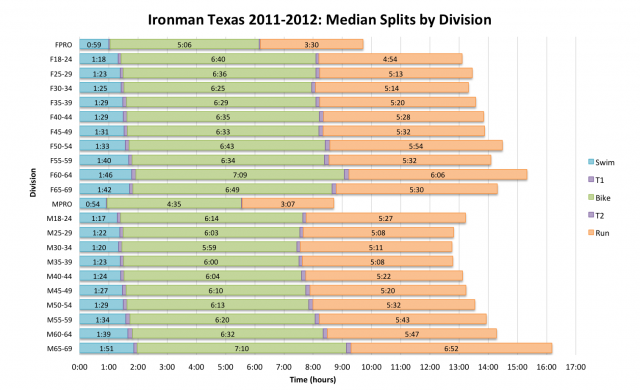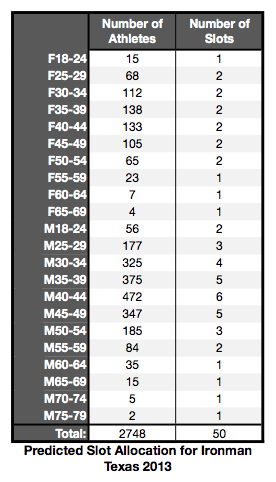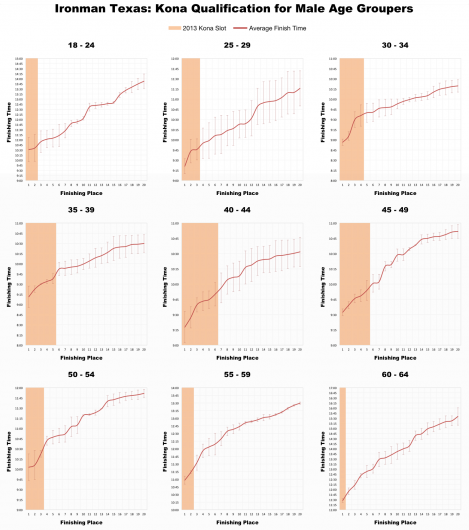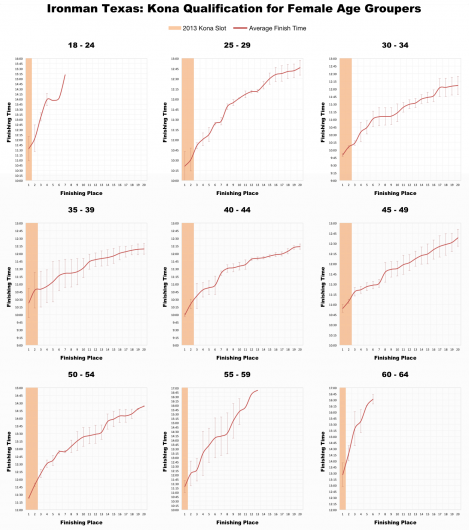The second Ironman taking place this weekend is a relative newcomer – Ironman Texas enters its 3rd year in comparison to Lanzarote’s 22nd. With youth comes a lack of experience, I only have 2 years of results from which to construct my usual pre-race analysis. We should be wary in drawing strong conclusions on the basis of such sparse data. Still, for those racing, I’ve looked at the distribution of splits, average finish times and the performances likely to earn a ticket to the Ironman World Championship.
The distribution of split times in Texas over the last two years could simply be described as unremarkable. The curves compare well to other large North American races – broad distributions indicative of a large field with a wide range of abilities. The charts imply a standard course, but having no personal experience of Ironman Texas I turned to the Endurance Corner Profile to ensure there were no challenges hidden in the data. Heat, humidity and wind are the potential difficulties; they don’t appear to weigh too heavily on the results.
Individual age group averages (medians to reduce the impact of outliers) may give a better insight into the nature of the race. Obviously times are a product of course, conditions and the athletes who race, it’s hard to completely separate the three. In the case of Texas they again show it to be typical of North American Ironman races; this broad spread of abilities within a large field results in run times north of 5 hours. Looking at the professional race offers a different angle – splits are faster, but not the fastest you will see in Ironman races.
Texas offers 10 more Kona slots than Lanzarote, although with 1,000 more athletes the odds aren’t any better. Based on the Bib List available on the Ironman.com website I’ve (in a painstaking cut-and-paste operation) calculated the likely distribution of Kona slots across the age groups below. Remember it’s the numbers who cross the start line that count towards the final allocation.
As always it’s the largest age groups, men between the ages of 30 and 50, who receive most of the slots, but you still need to be prepared to place within the top five or six. I can use the results from the last two years to calculate the fastest, average and slowest finish times for the top twenty places in each age group.
It’s worth remembering that with only 2 years of results behind this we should be cautious in interpreting these graphs. That said in the women’s field the spread between fastest and slowest is generally quite small, times appear to have been consistent so far. The men are a little more variable so it will be interesting to see the trends this year’s race produces. Male would-be Kona qualifiers should be aiming to go sub-10, a sub-9:45 being a better guarantee. As ever, you can only do what you can on the day.
I’ll be honest, without athletes racing in Texas my focus will be on Ironman Lanzarote this weekend. However I will have results and analysis up for both events at the start of next week.









